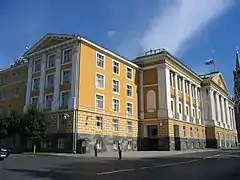Soviet of Nationalities
The Soviet of Nationalities (Russian: Совет Национальностей, Sovyet Natsionalnostey[1]) was the upper chamber of the Supreme Soviet of the Union of Soviet Socialist Republics, elected on the basis of universal, equal and direct suffrage by secret ballot in accordance with the principles of Soviet democracy. Until Glasnost and the 1989 elections, however, only candidates approved by the Communist Party of the Soviet Union were permitted to participate in the elections. It was briefly succeeded by the Soviet of the Republics from October to December of 1991. As opposed to the Soviet of the Union, the Soviet of Nationalities was composed of the nationalities of the Soviet Union, which in turn followed administrative division rather than being a representation of ethnic groups.
Soviet of Nationalities Совет Национальностей | |
|---|---|
| Legislative body in the Soviet Union | |
 | |
| History | |
| Established | 1938 |
| Disbanded | 1991 |
| Preceded by | Congress of Soviets |
| Succeeded by | None (USSR ceased to exist) |
| Leadership | |
Anuarbek Alimzhanov (last) | |
| Elections | |
| Direct elections (until 1989) Elected by the Congress of People's Deputies of the USSR (from 1989) | |
| Meeting place | |
 | |
| Kremlin Presidium, Moscow Kremlin | |
| This article is part of a series on the |
| Politics of the Soviet Union |
|---|
 |
Background
Prior to the creation of the Supreme Soviet in 1938 by the Soviet Constitution of 1936, the Soviet of Nationalities was one of the bodies that formed the Central Executive Committee of the Soviet Union, the other being the Soviet of the Union. Created by the 1924 Constitution to represent the national-territorial units of the Soviet Union in 1924, the Soviet of Nationalities included 5 delegates from union-level republics and ASSRs and 1 delegate from each autonomous oblast.[2]
History
The Soviet of the Nationalities was formed on the basis of equal representation of all the Republics of the Soviet Union (32 deputies from each republic, excluding other autonomous units inside that republic which sent in separate members), autonomous republics (11 deputies from each republic), autonomous oblasts (five deputies from each oblast), and national districts (one deputy from each district). As a result, the largest republic, the Russian SFSR with a population of 147 million, and the smallest republic, the Estonian SSR with a population of about 1.5 million, got 32 deputies each. Russians as an ethnic group made up more than half of the population of the Soviet Union, but the Soviet of Nationalities did not represent ethnic groups, it represented the different nationalities as expressed by the republics and various autonomous units of the Soviet Union. This electoral system seriously diminished representation of larger ethnic groups in favor of the smaller ethnic groups of the Soviet Union, with the Russians being most underrepresented.
The Soviet of Nationalities enjoyed the same rights as the Soviet of the Union in the area of legislative initiative and in resolving other issues inside the competence of the Soviet Union. In practice, until 1989, it did little more than approve decisions already made by the top leadership of the Communist Party of the Soviet Union. After the 1989 elections–the first, and as it turned out, only, free elections ever held in the Soviet Union–the Soviet of Nationalities acquired a much greater role, and was the scene of many lively debates.
The Soviet of Nationalities elected a chairman (who would lead the sessions of the chamber), his four deputies, and permanent commissions: Mandate Commission, Commission on Legislative Suppositions, Budget Planning Commission, Foreign Affairs Commission, Youth Affairs Commission, Industry Commission, Transportation and Communications Commission, Construction and Industry of Building Materials Commission, Agricultural Commission, Consumer Goods Commission, Public Education Commission, Science and Culture Commission, Trade Commission, Consumer Service and Municipal Economy Commission, Environmental Commission.
The presidium of the Soviet of Nationalities "ceased all noticeable work at the end of 1937", but it did "survive as the sole central political institution formally devoted to the nationalities question".[3]
In 1989, it was reduced to 271 deputies elected by the Congress of People's Deputies. Its deputies were elected representing national-territorial electoral districts and public organizations. In 1991, it was reorganised into the Soviet (or Council) of Republics, consisting of 20 deputies from each republic, and 1 from each autonomous republic, delegated by their legislatures, Russia being an exception with 52 deputies. It would pass decisions on the organization and working procedure of the Union bodies, ratify and denounce international treaties.
On December 26, 1991, the Soviet of the Republics adopted a resolution declaring that the Soviet Union no longer existed as a functioning state and voted both itself and the Soviet Union out of existence. The Soviet of the Union had effectively been dissolved two weeks earlier when Russia recalled its deputies, leaving it without a quorum. The Soviet of the Republics' declaration was thus the final legal step in the dissolution of the Soviet Union.
See also
- Chairman of the Soviet of Nationalities
- Korenizatsiya
- Soviet of Nationalities of the Russian SFSR
- 1977 Soviet Constitution
- 1936 Soviet Constitution
References
- Ukrainian: Раду Національностей; Belarusian: Савет Нацыянальнасцей; Lithuanian: Tautybių Taryba; Romanian: Sovietul Naționalităților (Moldovan Cyrillic: Советул Националитэцилор); Latvian: Tautību Padome; Turkmen: Миллетлер Совети; Estonian: Rahvuste Nõukogu
- Martin, Terry (Terry Dean) (17 January 2017). The affirmative action empire : nations and nationalism in the Soviet Union, 1923-1939. Ithaca. p. 247. ISBN 978-1-5017-1332-3. OCLC 606578236.
- Terry Martin, The Affirmative Action Empire: Nations and Nationalism in the Soviet Union, 1923-1939 (Cornell University Press, 2001: ISBN 0-8014-8677-7), p. 412.